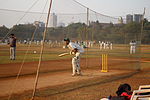2019 Mumbai foot overbridge collapse
2010s in Mumbai2019 disasters in India2019 in Maharashtra2019 road incidentsBridge disasters in India ... and 3 more
History of Mumbai (1947–present)March 2019 events in IndiaUse Indian English from January 2021
On 14 March 2019, in Mumbai city of India, a part of a foot overbridge connecting north-end of Chhatrapati Shivaji Maharaj Terminus (CSMT) railway station to Badaruddin Tayabji Lane collapsed and fell on the road. Six people died and at least 30 others were injured in the accident.
Excerpt from the Wikipedia article 2019 Mumbai foot overbridge collapse (License: CC BY-SA 3.0, Authors).2019 Mumbai foot overbridge collapse
Dr Dadabhai Naoroji Road, Mumbai A Ward (Zone 1)
Geographical coordinates (GPS) Address Nearby Places Show on map
Geographical coordinates (GPS)
| Latitude | Longitude |
|---|---|
| N 18.942203 ° | E 72.83466 ° |
Address
Mumbai CSMT (Suburban)
Dr Dadabhai Naoroji Road
400001 Mumbai, A Ward (Zone 1)
Maharashtra, India
Open on Google Maps






